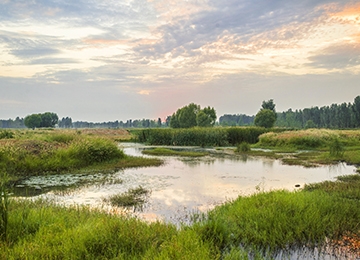Wetlands – Nature’s Sponges
Wetlands are protected by the Clean Water Act and regulated by the Environmental Protection Agency through the United States Army Corps of Engineers (USACE) Regulatory Division. Have you ever wondered why we protect wetlands? It’s just land that can’t be utilized for anything, right?
Well, not exactly.
Wetlands provide an array of positive functions for our environment. Some of the most important include reducing flooding impacts from storms, helping to maintain good water quality, providing natural carbon storage, and acting as critical breeding grounds for our nation’s waterfowl. In fact, certain wetlands are home to some of the rarest threatened and endangered species on earth.
Wetlands can be inundated with water, influenced by tides, or come from groundwater seeps or other hydrologic influences. Some wetlands don’t even appear “wet”; the water table may be at or just below the ground surface. Wetland habitats are home to certain types of tree and plant species (hydrophytes or hydrophytic vegetation), which are plants accustomed to growing in predominantly wet soils. Soils that are wet long enough to become oxygen depleted go through chemical reactions and are referred to as hydric soils, one of three criteria that defines a wetland. The remaining two criteria are wetland hydrology and hydrophytic vegetation. All three conditions must be present for an area to be considered a wetland.
Wetlands Development and Regulation
It is inevitable that development and wetlands will come into conflict. To minimize impacts to wetlands, it’s important to have experts identify and define the locations and boundaries of wetlands. Impacts to wetlands associated with development must be approved and permitted through the USACE.
Nationwide Permits (NWP) are general permits approved by the USACE that authorize activities across the country. Nationwide Permits allow for minor impacts to wetlands, as long as those impacts abide by conditions of the permit. Currently there are 52 Nationwide Permits. Depending on current standards of practice, or as new technology becomes available; the need to remove or add permits to the list is determined.
Expiration of Nationwide Permits
Every five years existing NWPs expire, as they will this year on March 18, 2017. Before expiration, the NWPs are open to refinement by the USACE; they can be updated or removed, and new permit types may be added. Project impacts covered under an existing permit will have a one year grace period to be completed after the March 18 expiration date. If the project can demonstrate sufficient planning/engineering and/or funds that have been attributed for the development, the permit will be extended. Otherwise, new projects permitted after the new NWPs have been approved will be subject to the conditions of the newly approved permits. These conditions may be the same, less, or more strict than their prior counterparts.
Wetland Preservation
Conservation of wetlands is clearly very important. Defining what is and what isn’t a wetland is imperative. Being good stewards of our natural resources, while maintaining the balance between conservation and progress, is paramount in today’s development community. Education, experience, expertise, and relationships among regulators, consultants and the development community continue to be an important piece in the conservation of our natural resources.
Author: W. Brandon Fulton, PWS, LSS, PSC
Mr. Fulton is an Environmental Principal with over 15 years of experience. He is a licensed soil professional in both North and South Carolina, and has particular expertise with soil and wetland projects from the coastal plain to the mountain regions of North Carolina, South Carolina, and Virginia.

